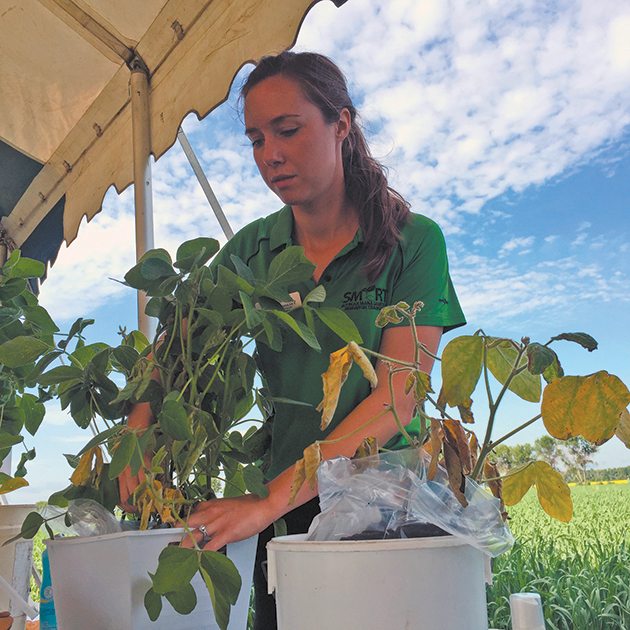CARMAN, Man. — It’s time for soybean growers to get out and get looking for phytophthora.
In Manitoba, conditions have been perfect for the disease to develop, and it is, disease specialists told farmers at a Manitoba Pulse and Soybean Growers soybean agronomy field day held at the Carman research farm July 20.
“It’s very random,” MPSG production specialist Kristin Podolsky said about the “sometimes no rhyme nor reason” pattern of the root disease.
“It’s really showing up at this time of year, right now with the prolonged wet conditions.”
Phytophthora root rot is common in soybean-growing regions, but many farmers new to the crop might not be used to it yet.
The disease damages the ability of the plant to feed itself and shows up above the surface in wasted plants with yellowed, wilted leaves that remain attached to the stem.
A common giveaway of its presence is stem lesions that continue from beneath the soil surface to above the soil surface.
The disease can show up in clumps or in individual plants spread throughout a field. The weak and stunted plants can often be hidden beneath healthier plants in the stand, so farmers need to get out into fields and pull apart the canopy to see if it’s there.
There’s no easy way to deal with it if it is beginning to appear. Seed treatments can offer some protection, but only for early season development. Phytophthora can appear all the way into August.
Read Also

Forecasts point toward snowy winter
Even though it’s expected to be weak, La Niña often brings colder-than-average winters across the Prairies, with wetter conditions in the west and drier weather in the east.
Rotation is the best defence for future crops.
“I think it should be one-in-four for every crop because we’re being proactive and preventative,” said Podolsky.
Shorter rotations increase the risk of the disease becoming widespread rather than sporadic.

Phytophthora comes in many forms, known as “races,” and each race acts differently. It is important for farmers to know what race is most active in their region so that they can pick resistant varieties.
“There are differences showing up between these varieties, so that is a really good, positive sign,” said Debra McLaren of Agriculture Canada in Brandon.
“We need to know what races we have in Manitoba.”
Race number four appears to dominate Manitoba farmland at the moment, while numbers three and four dominate in North Dakota and number 25 in Ontario.
Manitoba soybean growers have seen a lot of iron deficiency chlorosis this year because of the excessive moisture. However, while some of the symptoms are similar, educated eyes can easily see the difference, Podolsky said.
Farmers need to develop those educated eyes, especially with U.S. soybean root diseases approaching Canada. Soybean cyst nematode is expected to appear at some point, as well as other diseases not yet seen in Manitoba.
Podolsky urged farmers to keep a careful watch on what appears in their crops, especially if they are near the U.S. border or farm near the Red River. Those are the routes by which new diseases are likely to invade.















